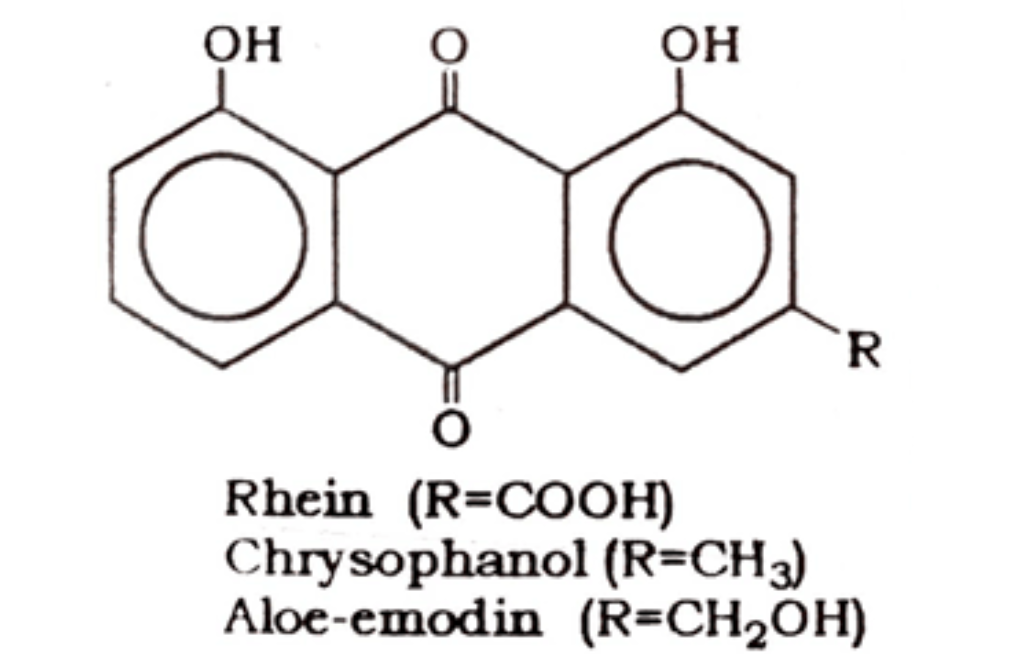Rhubarb: Biological Source, Therapeutic Uses, Morphological Features and MCQs

RHUBARB
1. Biological sources:
• The botanical name of rhubarb is Rheum officinale Bali.
• The biological source of rhubarb is the dried rhizome and roots of it.
• It is also known as rheum, radix rhei and rhubarb rhizome.
• It belongs to the polygonaceae family.
2. Morphological features:
• The length is upto 8-10 cm and the thickness is upto 3-4 cm.
• It is compact or rigid in nature.
• The shape of rhubarb roots is cylindrical or barrel .
• They are longitudinally wrinkled , ridged or furrowed.
• In some cases, they exhibit transverse annulations or wrinkles.
• They have a sharp characteristic odour .
• They posses a bitter astringent taste.
• The surface of rhizome is often smeared with a bitter yellowish powdery substance.
• They have smooth surface when upper surface removed.
• The inner surface is pale brown to red in color.
• Its diameter is 3-5 cm.
• Star spot is present within the cambium star spots.
• Cork and cortical cells are absent in rhubarb.
3. Chemical constituents:
• Rhubarb consist of anthraquinone glycosides and astringent components.
• The range is between 2- 4.5%.
• These anthraquinones are classified into four categories :
(1) Anthraquinones with –COOH moiety :e.g., rhein and glucorhein
(2) Anthraquinones without – COOH moiety: e.g., emodin; aloe-emodin; chrysophanol and physcion.
(3) Anthrones and dianthrones of emodin: e.g. emodine anthrone, emodin dianthrone.
(4) Heterodianthrones: e.g. palmidin A,B and C.
• In addition with above constituents, it also contain rheinolic acid and pectin.
• It also contain starch and fat.
• It has calcium oxalate as a chemical constituents and the range of it is between 3-40%.
• The examples of astringent substances are ghicogallin free gallic acid, catechins and epicatechins gallate.
4. Uses:
• The main use of rhubarb is in the form of ointment, applied in the treatment of and cure of chronic eczema and psoriasis.
• It is also used in the treatment of trichophytosis which is a potent keratolytic agent.
• It is used as a bitter stomachic in the treatment of diarrhea.
• It also have purgative property.
5. Adulterations:
The most common adulterants of rhubarb are rhapontic rhubarb and the stock roots of rumex alpines and rumex obtusifolius.
6. MULTIPLE CHOICE QUESTIONS:
1. What is the botanical name of rhubarb?
(a) Capsicum annuum
(b) Scabiosa caucasica
(c) Sedum acre
(d) Rheum officinale Bali.
2. What is the biological source of rhubarb?
(a) Leaves
(b) Roots
(c) Rhizomes
(d) Both b and c
3. Match the following with respect to the chemical constituents ?
i. Vinca A. Ephedrine
ii. Opium B. Vincristine
iii. Ephedra C. Protopine
iv. Rhubarb D. Anthraquinone
(a) i-A,ii-B,iii-C,iv-D
(b) i-B,ii-C,iii-A,iv-D
(c) i-C,ii-A,iii-B,iv-D
(d) i-D,ii-B,iii-A,iv-C
4. Choose incorrect statement with respect to the medicinal uses of plants.
i. Vinca is used to treat cancer.
ii. Opium is used to treat diabetes.
iii. Rhubarb is used to treat asthma.
iv. Nux vomica is used to treat neurasthenia.
(a) Both i and iv
(b) Only iii
(c) Both ii and iii
(d) Only i
5. What are the common adulterants of rhubarb?
(a) Rhaptonic rhubarb
(b) Stock roots of rumex alpines
(c) Crystal violet
(d) Both a and b
6. Anthraquinone is the chemical constituents of which plant?
(a) Black pepper
(b) Terpenes
(c) Ephedra
(d) Rhubarb
7. Rhubarb is used to treat
(a) Chronic eczema
(b) Psoriasis
(c) Trichophytosis
(d) All of the above
8. Chemical constituents of rhubarb are
(a) Starch
(b) Fats
(c) Calcium oxalate
(d) All of the above
9. Rhubarb is consist of which property?
(a) Antiseptic
(b) Purgative
(c) Anti-inflammatory
(d) All of the above
10. what is the length of root of rhubarb?
(a) 8-10 cm
(b) 5 cm
(c) 9 cm
(d) 7 cm
ANSWERS:
1. (d)
2. (d)
3. (b)
4. (b)
5. (d)
6. (d)
7. (d)
8. (d)
9. (b)
10. (a)
REFERENCE:
Evans W.C, Editors. Trease and Evans Pharmacognosy , New York, Saunders Elsevier; 2009, p.493.